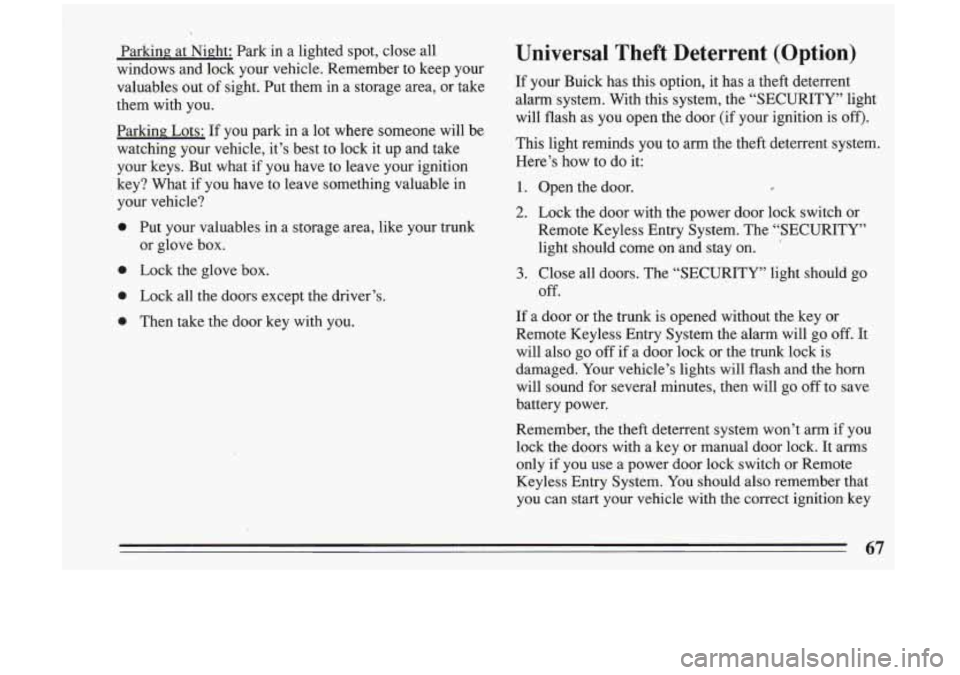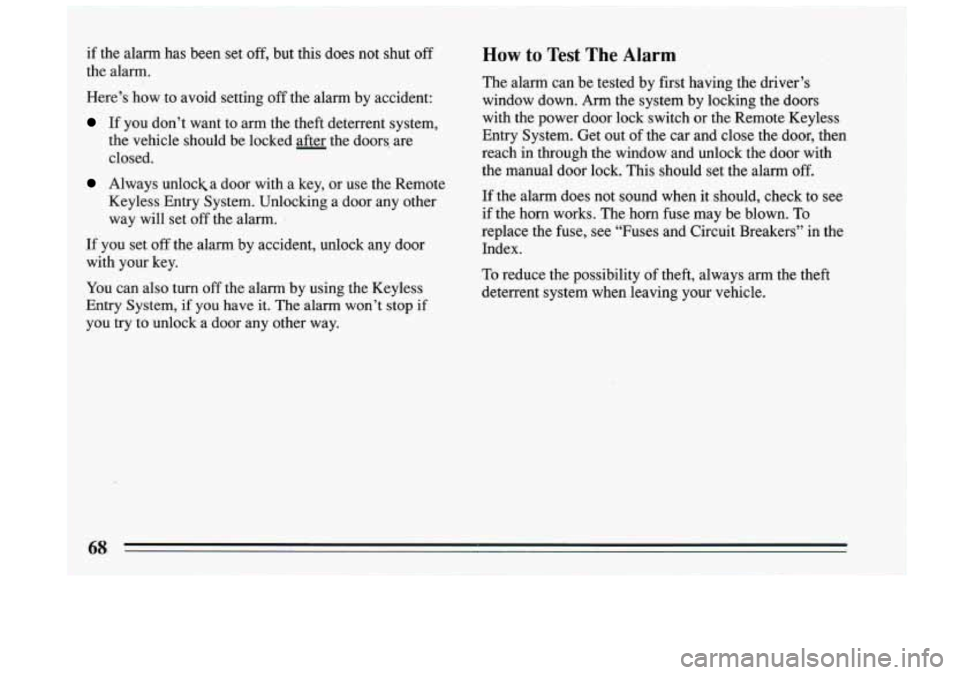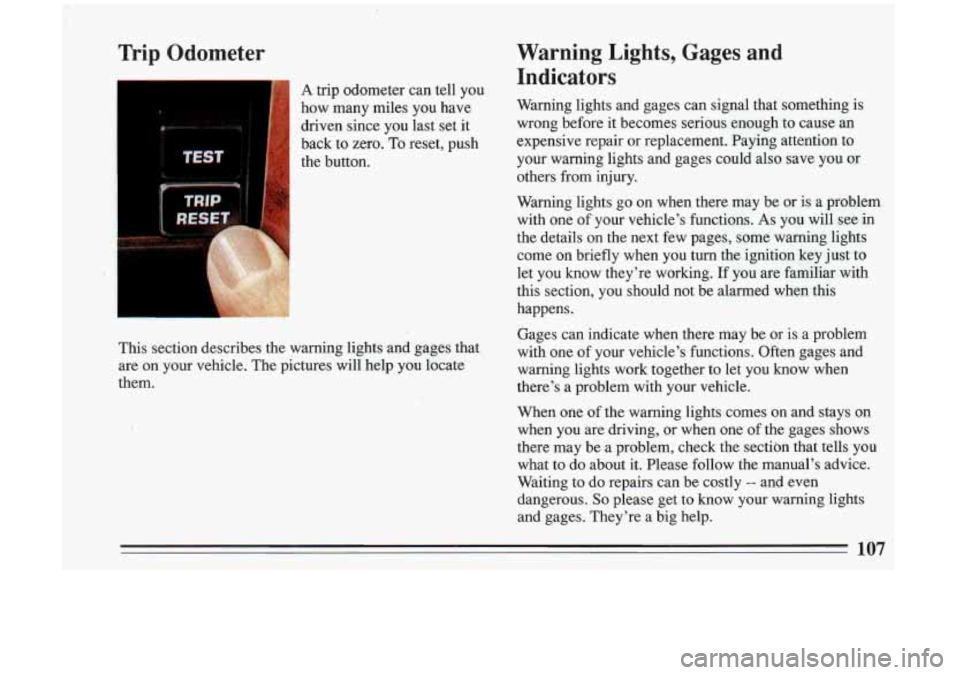Page 64 of 324
I
There are several ways to lock and unlock your vehicle: . From the inside: To lock the door, move the lock control
on the door down.
To unlock the door, move the lock control on the door
UP.
i
From the outside: Use your door key.
If your vehicle has a theft deterrent system and it is '
armed, unlock the doors only with the key or Remote Keyless Entry System (if you h-ave
one). This will avoid
setting
off the alarm.
L
62
Page 69 of 324

Parking at Night: Park in a lighted spot, close all
windows and lock your vehicle. Remember to keep your
valuables out of sight. Put them in a storage area, or take
them with you.
Parking Lots: If
you park in a lot where someone will be
watching your vehicle, it’s best to lock it up and take
your keys. But what if you have to leave your ignition
key? What if you have to leave something valuable in
your vehicle?
0
0
0
0
Put your valuables in a storage area, like your trunk
or glove box.
Lock the glove box.
Lock all the doors except the driver’s.
Then take the door key with you.
Universal Theft Deterrent (Option)
If your Buick has this option, it has a theft deterrent
alarm system. With this system, the “SECURITY” light
will flash as you open the door (if your ignition is
off).
This light reminds you to arm the theft deterrent system.
Here’s how to do it:
1.
2.
3.
Open the door.
Lock the door with the power door lock switch or
Remote Keyless Entry System. The “SECURITY”
light should come on and stay on.
Close all doors. The “SECURITY” light ‘should go
off.
If a door or the trunk is opened without the key or
Remote Keyless Entry System the alarm will go off. It
will also go off
if a door lock or the trunk lock is
damaged. Your vehicle’s lights will flash and the horn
will sound for several minutes, then will go
off to save
battery power.
Remember, the theft deterrent system won’t arm if you lock the doors with a key or manual door lock. It arms
only
if you use a power door lock switch or Remote
Keyless Entry System. You should also remember that
you can start your vehicle with the correct ignition key
67
Page 70 of 324

if the alarm has been set off, but this does not shut off
the alarm.
Here’s how to avoid setting off the alarm by accident:
If you don’t want to arm the theft deterrent system,
the vehicle should be locked after the doors, are
closed.
Always unlocks door with a key, or use the Remote
Keyless Entry System. Unlocking a door any other way will set
off the alarm.
If you set
off the alarm by accident, unlock any door
with your key.
You can also turn
off the alarm by using the Keyless
Entry System, if
you have it. The alarm won’t stop if
you try to unlock a door any other way.
How to Test The Alarm
The alarm can be tested by first having the driver’s
window down. Arm the system by locking the
doors
with the power door lock switch or the Remote Keyless
Entry System. Get out of the car and close the door, then
reach in through the window and unlock the door with
the manual door lock. This should set the alarm off.
If the alarm does not sound when it should, check to see
if the horn works. The horn fuse may be blown. To
replace the fuse, see “Fuses and Circuit Breakers” in the
Index.
To reduce the possibility of theft, always arm the theft
deterrent system when leaving your vehicle.
68
Page 109 of 324

Trip Odometer
I
Warning Lights, Gages and Indicators
A trip odometer can tell you
how many miles you have Warning lights and gages can signal t\
hat something is
driven since you last set it wrong before it becomes serious enough to cause an
back to zero.
TO reset, push expensive repair or replacement. Paying attention to
the button. your warning lights and gages could also save you or
others from injury.
Warning lights go on when there may be or
is a problem
with one
of your vehicle's functions. As you will see in
the details on the next few pages, some warning lights come on briefly when you turn the ignition key just to
let you know they're working.
If you are familiar with
this section, you should not be alarmed when this
happens.
This section describes the warning lights and gages that
are on your vehicle. The pictures will help
you locate
them. Gages can indicate when there may be or is a problem
with one
of your vehicle's functions. Often gages and
warning lights work together to let you know when
there's a problem with your vehicle.
When one of the warning lights comes on and stays on
when you are driving, or when one of the gages shows
there may be a problem, check the section that tells
you
what to do about it. Please follow the manual's advice.
Waiting to do repairs can be costly
-- and even
dangerous.
So please get to know your warning lights
and gages. They're a big help.
107